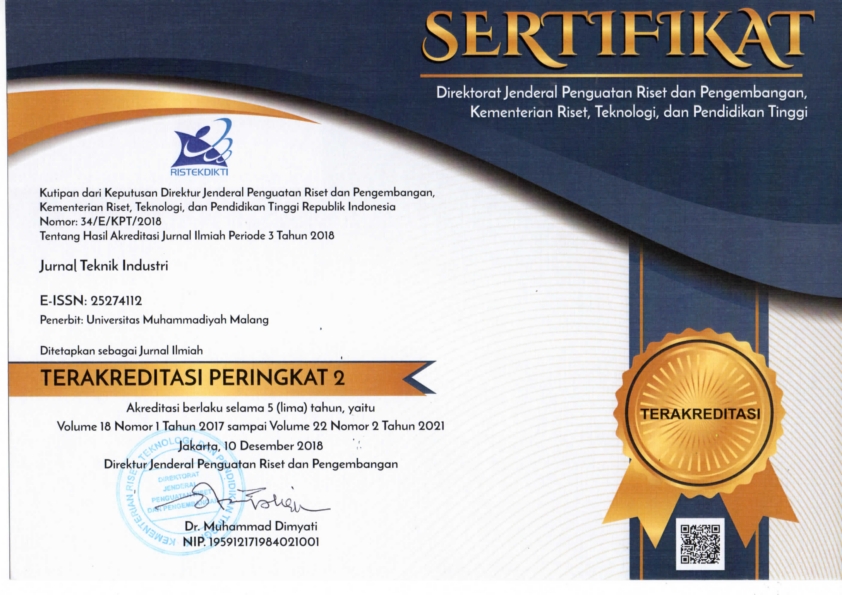Penggunaan Metode Heart Dan JSA Sebagai Upaya Pengurangan Human Error Pada Kecelakaan Kerja Di Departemen Produksi
DOI:
https://doi.org/10.22219/JTIUMM.Vol17.No1.1-11Keywords:
HEART, JSA, Accidents, HEP, Dangerous JobsAbstract
Occupational health and safety is very important point for a company. CV. XYZ is a company that produces paving and have problem about the occupational accident. There are 4 production procceses that can be couse occupational accidents, which is taking raw materials procces, stirring batter, forming and drying. This case must be analyzed using HEART and JSA method as evaluating effort for occupational accident. The results of HEART method analysing imply that HEP value 0,8632is the most dangerous occupational, that is forpicking gravel from cement mixer machine. After known the value of HEP afterward analyzed using JSA method. The goal is as improvement to occupational accident in the production process in order can be reduced. The result of JSA method analysing are improvement suggestion such us levying mask, hat, design of additional components for machine, additional equipment for pallet and hand pallet, and assigning standart operational procedure.Downloads
References
G. Laing, J. Bruce, D. Skinner, N. Allorto, C. Aldous, S. Thomson, et al., "Using a hybrid electronic medical record system for the surveillance of adverse surgical events and human error in a developing world surgical service," World journal of surgery, vol. 39, pp. 70-79, 2015.
D. Pandya, L. Podofillini, F. Emert, A. Lomax, and V. Dang, "PO-0994: Human error analysis in radiotherapy: first steps towards a prospective and quantitative method," Radiotherapy and Oncology, vol. 115, pp. S532-S533, 2015.
W. P. Sari, E. L. Mahyuni, U. Salmah, M. D. Keselamatan, and D. D. Keselamatan, "Faktor-Faktor Yang Memengaruhi Potensi Kecelakaan Kerja Pada Pengemudi Truk Di Pt Berkatnugraha Sinarlestari Belawan Tahun 2015," Faktor-faktor yang Memengaruhi Potensi Kecelakaan Kerja pada Pengemudi Truk di PT Berkat Nugraha Sinar Lestari Belawan Tahun 2015, 2015.
P. Ginting, R. Matondang, and B. Buchari, "Analisis Program Keselamatan dan Kesehatan Kerja di Bagian Produksi dengan 5s dalam Konsep Kaizen sebagai Upaya Pencegahan Kecelakaan Kerja di Pt. xyz," Jurnal Teknik Industri USU, vol. 3, 2014.
X. Su, S. Mahadevan, P. Xu, and Y. Deng, "Dependence assessment in human reliability analysis using evidence theory and AHP," Risk Analysis, vol. 35, pp. 1296-1316, 2015.
Y. Rasoulzadeh, S. S. Alizadeh, S. Valizadeh, H. Fakharian, and S. Varmazyar, "Health, safety and ergonomically risk assessment of mechanicians using Job Safety Analysis (JSA) technique in an Iran City," Indian Journal of Science and Technology, vol. 8, 2015.
J. Williams, "HEART—a proposed method for achieving high reliability in process operation by means of human factors engineering technology," in Safety and Reliability, 2015, pp. 5-25.
S. Mandal, K. Singh, R. Behera, S. Sahu, N. Raj, and J. Maiti, "Human error identification and risk prioritization in overhead crane operations using HTA, SHERPA and fuzzy VIKOR method," Expert Systems with Applications, vol. 42, pp. 7195-7206, 2015.
S. Zhang, F. Boukamp, and J. Teizer, "Ontology-based semantic modeling of construction safety knowledge: Towards automated safety planning for job hazard analysis (JHA)," Automation in Construction, vol. 52, pp. 29-41, 2015.
P. Martino, D. I. Rinawati, and R. Rumita, "Analisis Identifikasi Bahaya Kecelakaan Kerja Menggunakan Job Safety Analysis (JSA) Dengan Pendekatan Hazard Identification, Risk Assessment And Risk Control (HIRARC) di PT. Charoen Pokphand Indonesia-Semarang," Industrial Engineering Online Journal, vol. 4, 2015.











